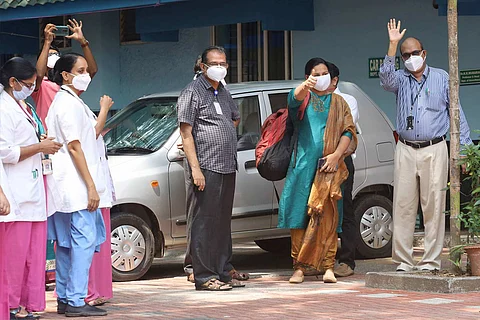

It’s been 97 days since India recorded its first COVID-19 case on January 30 when a medical student from Wuhan in China returned to Kerala. Since then, the epidemic has surged across the country with nearly 50,000 confirmed patients and 1694 deaths as of Wednesday evening, as per figures by the Union Ministry of Health and Family Welfare.
And while states like Maharashtra, Gujarat and Delhi have seen huge spikes in infections, Kerala has over the past few weeks emerged as a model for its containment strategy. The state that witnessed the first three COVID-19 cases in the country has not only managed to rein in the number of infections but also has the distinction of recording one of the highest recovery rates.
Out of the total 503 patients who have tested positive for the SARS-CoV-2 virus that causes the COVID-19 disease, 469 persons have recovered in Kerala, and only 30 are still under hospitalisation. The state’s recovery rate is a whopping 93.24% far beyond the national average of 28.71%.
Kerala’s numbers stand out in comparison to other states that have over 100 cases. At 57.29% Telangana comes a distant second when it comes to recoveries. Rajasthan (49.25%) Karnataka (49.18%) and Andhra( 41.02%) are also among the states with the highest rate of recoveries.
Significantly, Kerala has also managed to keep its mortality rate low at 0.79% with 4 deaths due to COVID-19 so far. This too is well below the national mortality rate of 3.42%.
Speaking to TNM, Dr Amar Fettle, Kerala’s nodal officer for infectious diseases, modestly insists that the state went by the rule book. “From the medical side of it, I don’t think there is a specific thing we are doing. We have identified them (positive cases) as early as possible,” says Dr Amar, adding that Kerala has been following the standard protocol prescribed by the Indian Council of Medical Research (ICMR).
However, the difference between Kerala and the rest may lie in the speed at which the state managed to trace contacts of confirmed COVID-19 patients and contain the spread of the virus.
“For every patient who came in, we traced 100 contacts of an infected patient. And we quarantined them well, and also during the quarantine period, we observed them regularly so that they don’t go out and infect other patients,” explains Dr B Ekbal, who heads the state expert committee that advises the Kerala government on the coronavirus.
The state also has a robust public health system with good facilities in most districts. Coronavirus patients were mainly treated at medical colleges across the state.
Another key reason for Kerala’s high recovery rate is the fact that a bulk of the patients had mild symptoms, say Dr Amar and Dr Ekbal. The nodal officer says that Kerala has had some severe cases, but explains,“The ancillary and support facilities that are available are quite good. We support them well. We give them psychological support during the period. All the other things are standard procedure as per protocol.”
It has also helped Kerala that many COVID-19 patients are relatively young. A majority of the COVID-19 patients in Kerala are between the ages of 21 and 50. But this posed other challenges for the state administration, points out Dr Ekbal. “Kerala’s patients were the ones who came from outside india. These were relatively younger patients. When they came in, we had a problem because we have a high elderly population and those with comorbidities,” he says.
To ensure that this vulnerable group is protected, Dr Ekbal says, “We gave instructions to the community that all persons above 65 years and with comorbidities should limit contact. So this group comes up to 71-72 lakh, they were self-quarantined in their homes. Through this, we prevented the contact of young patients with the elderly population. We prevented the infection from passing to elderly by effectively doing the quarantine.”
Pointing out that there is no specific treatment for COVID-19 and that supportive care plays a major role in the recovery of a patient, Dr Amar notes, “With regard to what is causing recovery in sicker patients, whether it is more oxygen or some other factor, that is changing everyday.”
“I would love to say all the support and loving care is causing them to recover. But there is no evidence,” Dr Amar says with a laugh.